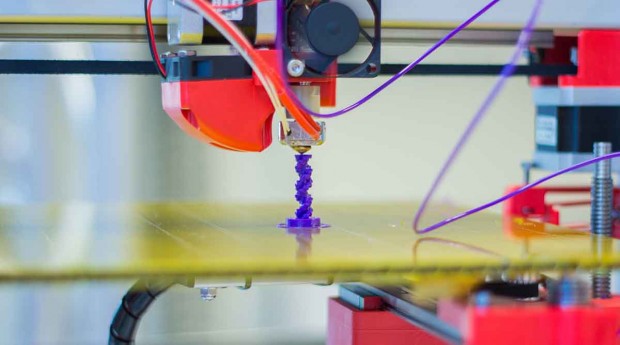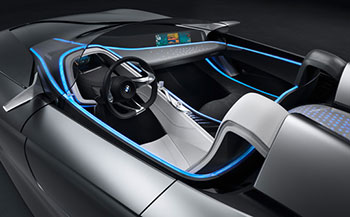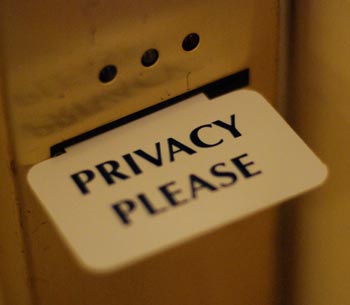"Software Intelligence in the Physical World" entries

Signals from the O’Reilly 2015 Solid Conference
Insight and analysis on the Internet of Things and the new hardware movement.
Practitioners, entrepreneurs, academics, and analysts came together in San Francisco this week to discuss the Internet of Things and the new hardware movement at the O’Reilly 2015 Solid Conference. Below we’ve assembled notable keynotes and interviews from the event.
Lock in, lock out: DRM in the real world
Author and activist Cory Doctorow uses his Solid keynote to passionately explain how computers are already entwined in our lives and our bodies, which means laws that support lock-in are much more than inconveniences. Doctorow also discusses Apollo 1201, a project from the Electronic Frontier Foundation that aims to eradicate digital rights management (DRM).

Practical advice for hardware startups
Entering the hardware space is easier than ever. Succeeding is a different matter.

Because of recent innovations in prototyping, crowdfunding, marketing, and manufacturing, it has never been easier — or cheaper — to launch a hardware startup than it is now. But while turning a hardware project into a product is now relatively easy, doing it successfully is still hard.
Renee DiResta and Ryan Vinyard, co-authors of The Hardware Startup, recently got together with Solid Conference chair Jon Bruner to discuss the startup landscape in hardware and the IoT, and what entrepreneurs need to know to build their businesses. Read more…

Mining the value of the IoT
Michael Chui on the hidden value locked within the Internet of Things.

Jon Bruner and Dr. Michael Chui recently discussed Chui’s latest research on the Internet of Things as part of our IoT Profiles Series. A full recording of their conversation is embedded at the end of this post—and it’s well worth watching—but here’s a look at a few key points that were made. Chui will expand on these ideas and debut his new report during his session, “Beyond the hype; Mining the value of the IoT,” at the upcoming O’Reilly Solid Conference (June 23-25 in San Francisco).
Comparing B2B and consumer applications
A lot of the hype surrounding the IoT is centered around consumer products, and while Chui sees tremendous value in the consumer arena, the business-to-business (B2B) market holds particular promise. “There’s double the amount of value in B2B applications as there are in consumer applications,” he says. The value, he says, “is in logistics and manufacturing and many of those applications.”
Even in consumer applications, he adds, B2B2C (business-to-business-to-consumer) applications can multiply value. ”When, in fact, the consumer health care health monitor can be connected to my provider, to my doctor, and have that continuous stream of health data actually connect up to the professional health care system, that’s where we think a lot of value can be created.” [Discussed at the 5:08 mark.] Read more…

Beacosystem evolution, hurdles, and resources
A look at the issues and trends in deploying beacon-based solutions.
In this post, the third of our series, I’ll look at some of the issues in using and deploying beacon-based solutions, some of the trends in both hardware and software offerings, and share some resources where you can find more detail on everything I’ve covered so far.
First off, let’s take a look at some of the topics that can cause issues, or trip us up when starting to consider a new iBeacon-based solution. In no particular order, these include:
Notifications, Notifications, Notifications
I have many conversations with potential clients that go something like this (in condensed form):
Client: “We want to do a beacon project”
Me: “Great, what are you thinking of?”
Client: “We want to trigger messages to people as they come past or in to our place on their phones”
Me: “OK, is this iOS only?”
Client: “No – of course not – in fact, most of our users are on Android”
Me: “Ah – ok… well…”
(long conversation follows)
With the initial hype and excitement around iBeacon, it’s understandable that there’s some confusion around what’s possible, and what’s not, across all the mobile handsets available today. For now, I’ll focus on just iOS and Android, though we could usefully expand to include Windows and Blackberry. Read more…

Why the Internet of Things isn’t the same as the new hardware movement
Cheap, accessible, open hardware is driving the IoT.
![]()
The Internet of Things (IoT) has been committing a lot of buzzword imperialism lately. It’s a hot term, marching across the technological countryside and looking for rich disciplines to capture. Electronics, manufacturing, and robotics, among others, have all become dominions of the IoT. The result is that the meaning of IoT has broadened to include practically anything that involves 1. technology, and 2. something physical.
At the same time, practitioners have been trying to escape the IoT — and its early association with Internet-connected refrigerators — for years. Big enterprises that want to develop serious applications for the Internet of Things have come up with other terms for what they’re doing, like Internet of Everything (Cisco) and Industrial Internet (GE).
Let’s put a stop to this and define some boundaries. In my view, the Internet of Things is the result of a much larger and more important movement that’s about making the physical environment accessible in the same way that the Internet has become accessible over the last 20 years. I’ll call this the “new hardware movement.” Read more…

Google’s Physical Web vs Apple’s iBeacon
How proximity approaches compare and a look at the flourishing proximity startup ecosystem.
Editor’s note: This is the second post in a series looking at beacon technology and the burgeoning beacon ecosystem.
In the first of this series, I covered some of the basics behind proximity, Bluetooth Low Energy, and iBeacon, and walked through some use cases where proximity and iBeacon have started showing up in retail, travel, and other applications.
While iBeacon has arguably galvanised the notion of using proximity in applications and services, it’s not the only game in town.
In this post, I’ll cover one of the alternatives to Apple’s iBeacon, Physical Web from Google, and then I’ll zoom out to look at the flurry of activity in startups in the evolving “Beacosystem.”
First, a small recap on what helped iBeacon gain so much traction, so quickly and helped shape the landscape for a proximity ecosystem to emerge.
Creating an ecosystem
Apple’s iBeacon is a layer, or a “convention,” that builds on the Bluetooth Low Energy (BLE) Standard. Apple has spurred an ecosystem around iBeacon by doing several things, which all feed into each other:
- Baked support for iBeacon into its mobile operating system (iOS) so that APIs are readily available for developers.
- Included support for background notifications at the OS level, so that push notifications can be triggered in certain situations, but without killing your phone’s battery.
- Provided a certification program to enable hardware manufacturers to create iBeacon-compatible hardware. This allows third-party manufacturers to provide iBeacon-compatible hardware of all shapes, sizes, and form factors, At last count, there were more than 50 suppliers of iBeacon hardware.
- Enabled every iOS device to be an iBeacon. This has many potential uses, from iPad-based POS systems welcoming you to a store, to the Hailo App letting you know that you can pay by Hailo.
- Ate its own dog food, by using iBeacon with their Apple Store App in all their US based Apple Stores.

The VR growth cycle: What’s different this time around
A chat with Tony Parisi on where we are with VR, where we need to go, and why we're going to get there this time.
Consumer virtual reality (VR) is in the midst of a dizzying and exhilarating upswing. A new breed of systems, pioneered by Oculus and centered on head-worn displays with breakthrough quality, are minting believers — whether investors, developers, journalists, or early-adopting consumers. Major new hardware announcements and releases are occurring on a regular basis, game studios and production houses big and small are tossing their hats into the ring, and ambitious startups are getting funded to stake out many different application domains. Is it a boom, a bubble, or the birth of a new computing platform?
Underneath this fundamental quandary, there are many basic questions that remain unresolved: Which hardware and software platforms will dominate? What input and touch feedback technologies will prove themselves? What are the design and artistic principles in this medium? What role will standards play, who will develop them, and when? The list goes on.
For many of these questions, we’ll need to wait a bit longer for answers to emerge; like smartphones in 2007, we can only speculate about, say, the user interface conventions that will emerge as designers grapple with this new paradigm. But on other issues, there is some wisdom to be gleaned. After all, VR has been around for a long time, and there are some poor souls who have been working in the mines all along. Read more…

A new dawn of car tech: customization through software, not hardware
Three ways entrepreneurs can bring the rate of progress we’ve seen in computing and communication to car tech.

BMW’s Vision ConnectedDrive concept car. Image: BMW.
Skeptics will cite the arduous three-to-six-year automotive design cycles, onerous qualification requirements, and thin margins that plague the automotive value chain. By attracting the greatest engineers and entrepreneurs, the car business of the early 20th century took us from horseback to stylish coupes within a generation, soon to be followed by tire-smoking muscle cars. Cars built during and after the late 80s pollute less over their lifetimes than their predecessors did parked. Sound like Moore’s Law to you? Read more…

Design’s role is to bridge context gaps
Andrew Hinton on making context understandable, smart devices, and programming literacy.
I sat down with Andrew Hinton, an information architect at The Understanding Group and author of the recently released O’Reilly book Understanding Context. Our conversation included a discussion of information architecture’s role in the context of the IoT, the complexities of context, and the well-debated “everyone should learn to code” argument.
Context, information architecture, and experience design
Information architecture (IA) has always been a critical part of creating great products and services, and many would argue that, until now, it hasn’t been given the attention or respect it deserves. The need for thoughtful IA is increasing as we enter the multimodal world of IoT. Whether you call yourself an Information Architect or Designer, you need to care about context. Hinton offers up this hidden motivation for writing Understanding Context:
“I’ll confess, the book is a bit of a Trojan horse to kind of get people to think about information architecture differently than maybe the way they assume they should think about it.”
I followed up with Hinton via email for a bit more on how we need to view IA:
“People tend to assume IA is mainly about arranging objects, the way we arrange cans in a cupboard or books in a library. That’s part of it, but the Internet has made it so that we co-exist in places made of semantic and digital information. So when we create or change the labels, relationships, and rules of those places, we change their environment. Not just on screens, but now outside of screens as well. And, to me, the central challenge of that work is making context understandable.”

There is room for global thinking in IoT data privacy matters
The best of European and American data privacy initiatives can come together for the betterment of all.
Editor’s note: This is part of a series of posts exploring privacy and security issues in the Internet of Things. The series will culminate in a free webcast by the series author Dr. Gilad Rosner: Privacy and Security Issues in the Internet of Things will happen on February 11, 2015 — reserve your spot today.
 As devices become more intelligent and networked, the makers and vendors of those devices gain access to greater amounts of personal data. In the extreme case of the washing machine, the kind of data — who uses cold versus warm water — is of little importance. But when the device collects biophysical information, location data, movement patterns, and other sensitive information, data collectors have both greater risk and responsibility in safeguarding it. The advantages of every company becoming a software company — enhanced customer analytics, streamlined processes, improved view of resources and impact — will be accompanied by new privacy challenges.
As devices become more intelligent and networked, the makers and vendors of those devices gain access to greater amounts of personal data. In the extreme case of the washing machine, the kind of data — who uses cold versus warm water — is of little importance. But when the device collects biophysical information, location data, movement patterns, and other sensitive information, data collectors have both greater risk and responsibility in safeguarding it. The advantages of every company becoming a software company — enhanced customer analytics, streamlined processes, improved view of resources and impact — will be accompanied by new privacy challenges.
A key question emerges from the increasing intelligence of and monitoring by devices: will the commercial practices that evolved in the web be transferred to the Internet of Things? The amount of control users have over data about them is limited. The ubiquitous end-user license agreement tells people what will and won’t happen to their data, but there is little choice. In most situations, you can either consent to have your data used or you can take a hike. We do not get to pick and choose how our data is used, except in some blunt cases where you can opt out of certain activities (which is often a condition forced by regulators). If you don’t like how your data will be used, you can simply elect not to use the service. But what of the emerging world of ubiquitous sensors and physical devices? Will such a take-it-or-leave it attitude prevail? Read more…

